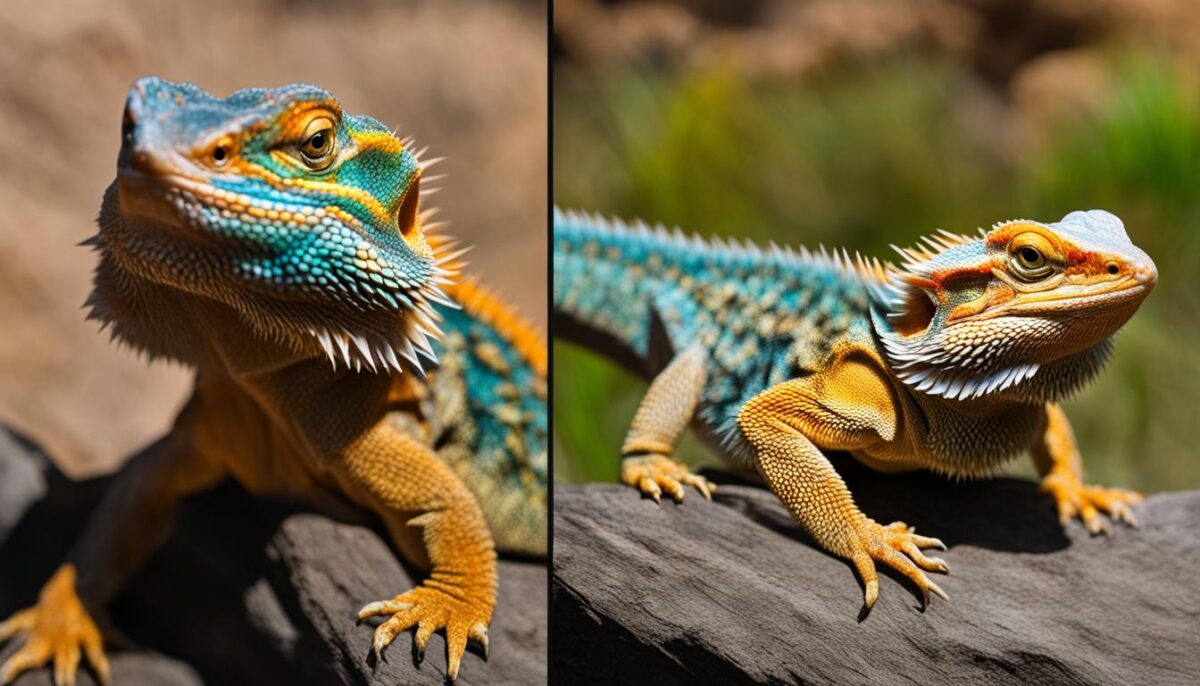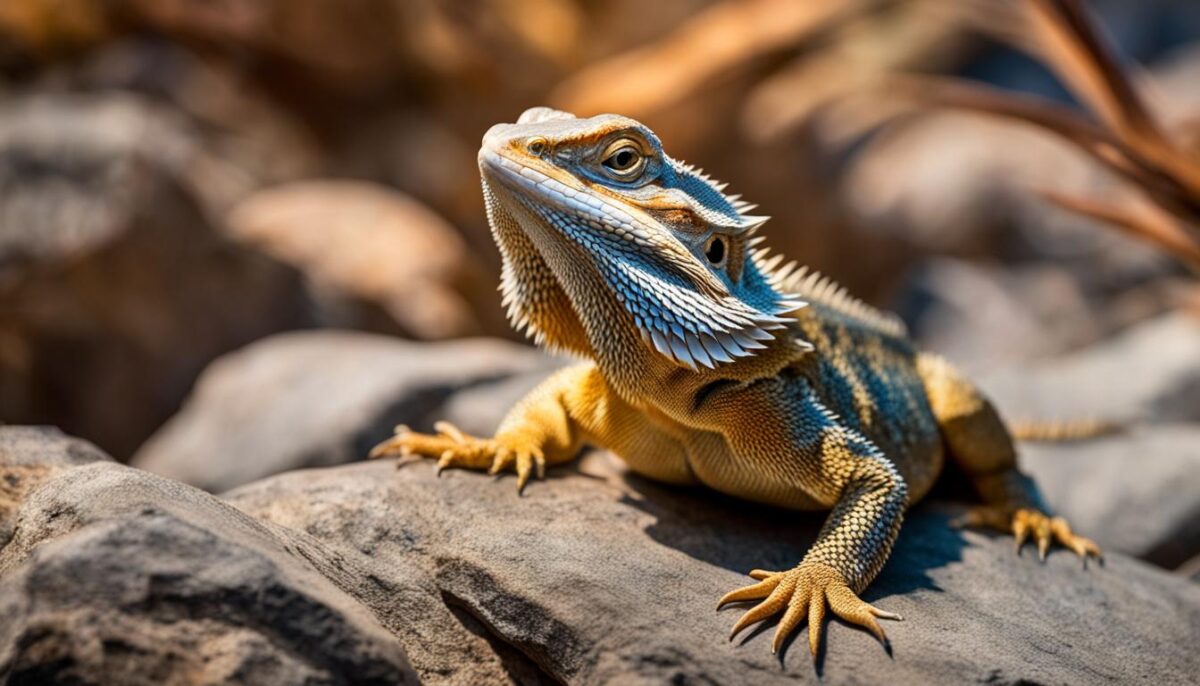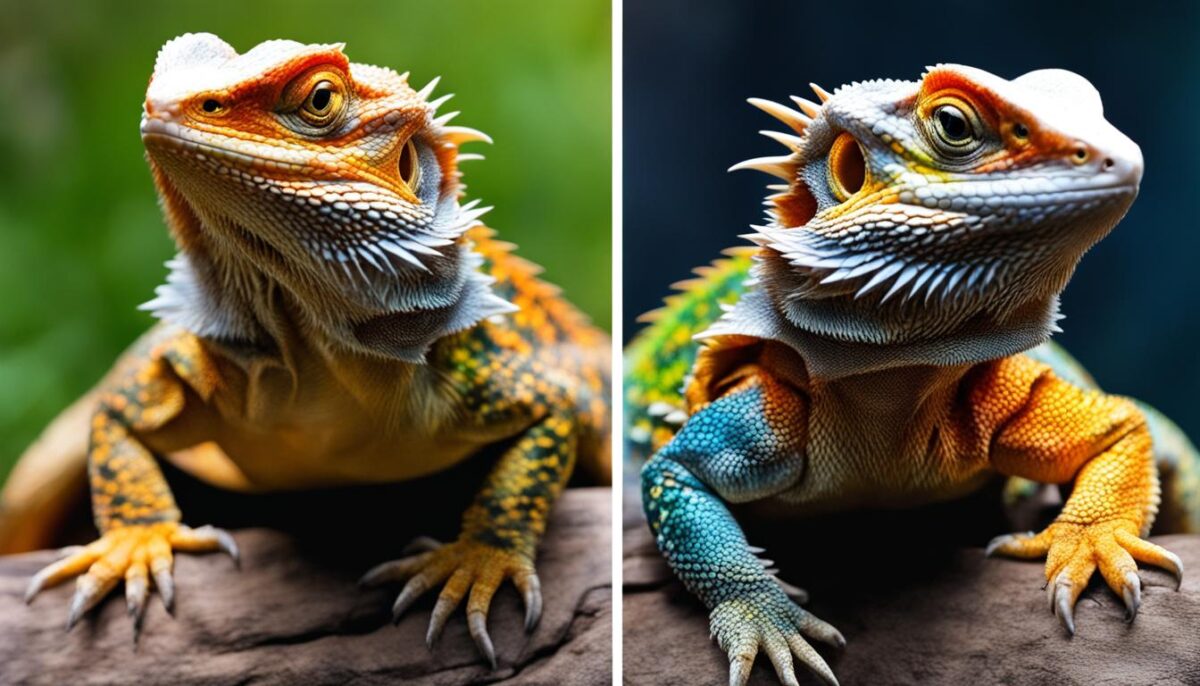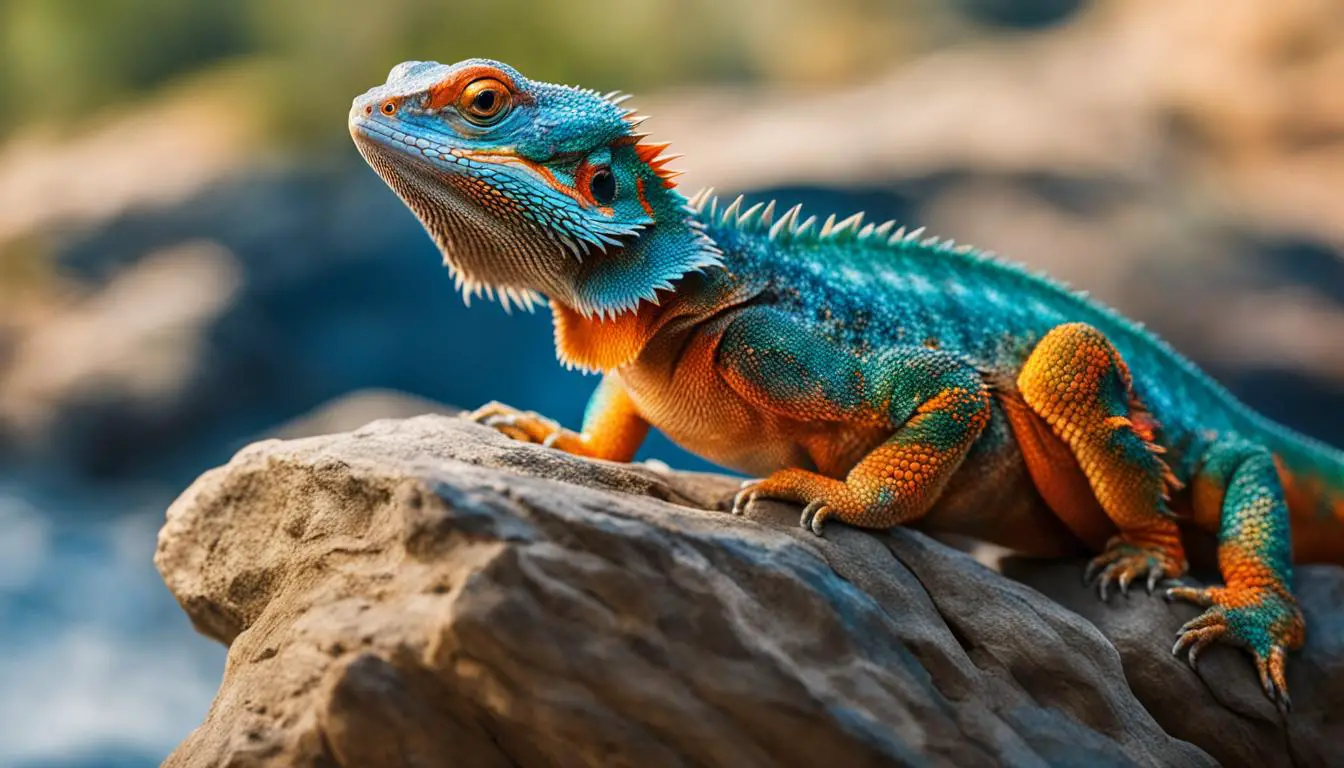Bearded dragons are fascinating creatures known for their ability to change color as they age. It’s not uncommon to find a bearded dragon with two different colors, which can be a delightful surprise for owners. This color change, also known as color fading, is a natural part of their development and can begin around 12-18 months of age. Understanding the reasons behind these color changes can help you provide the best care for your beloved pet.
Throughout this article, we will explore the factors that influence a bearded dragon’s color changes, including temperature, stress, and camouflage. We will also dive into their natural lifecycle, the impact of age and genetics on color variations, and how to care for bearded dragons with color changes. Whether you’re a seasoned bearded dragon owner or a curious enthusiast, this article will provide you with valuable insights into the fascinating world of these amazing reptiles.
Key Takeaways:
- Bearded dragons can have two different colors as part of their natural color fading process as they age.
- The factors that influence color changes in bearded dragons include temperature, stress, and the need for camouflage.
- Proper care, including a suitable habitat, appropriate temperature gradient, and a balanced diet, is essential for maintaining the health and vibrancy of their colors.
- Observing significant changes in color and consulting with a veterinarian when necessary is crucial for their overall well-being.
Bearded Dragon 2 Different Colors
The Natural Lifecycle of Bearded Dragons
Bearded dragons go through a natural lifecycle that includes growth, development, and color changes. These fascinating creatures typically reach full maturity around 11 to 12 months of age, although some may take up to 18 months to reach adulthood. During this time, they go through various stages of growth and development, resulting in changes in their size and appearance. bearded dragon calendar
The size of a bearded dragon can vary depending on factors such as age and genetics. Generally, they start off as tiny hatchlings, measuring just a few inches in length. As they grow, their bodies gradually elongate, and their limbs become more robust. By the time they reach adulthood, they can range in size from 16 to 24 inches, with males typically being larger than females. bearded dragon calendar for sale
Proper nutrition plays a significant role in the growth and overall health of bearded dragons. These reptiles are omnivores, meaning they eat a variety of foods, including insects, vegetables, and fruits. Providing a well-balanced diet that meets their nutritional needs is crucial for their development and well-being. It’s important to consult with a veterinarian or reptile specialist to ensure you are feeding your bearded dragon the right foods in the appropriate quantities. bearded dragon gifts bearded dragon merchandise
| Age | Size |
|---|---|
| Hatchling | 2-4 inches |
| Juvenile | 8-12 inches |
| Adult | 16-24 inches |
In conclusion, the natural lifecycle of bearded dragons involves gradual growth, development, and color changes. Providing proper nutrition and care during each stage of their life is crucial for their overall well-being. By understanding their lifecycle and the factors that influence their growth and appearance, you can ensure that your bearded dragon thrives and remains healthy throughout its lifespan.
Factors Influencing Color Changes in Bearded Dragons
Color changes in bearded dragons are a fascinating phenomenon that can be influenced by various factors. Understanding these factors is crucial in providing proper care and ensuring the well-being of your reptile companion. Let’s explore the key factors that contribute to color changes in bearded dragons:
Temperature
Temperature plays a significant role in the color variations of bearded dragons. These reptiles are ectotherms, meaning their body temperature is regulated by their environment. When temperatures drop, bearded dragons may darken their skin to absorb more heat and maintain their body temperature. Conversely, warmer temperatures can cause them to lighten in color, reflecting excess heat. It’s important to provide a well-regulated enclosure with a proper temperature gradient to support healthy color changes in your bearded dragon.
Stress
Stress and anxiety can also impact the coloration of bearded dragons. When they experience stress, whether from environmental changes, handling, or social interactions, their colors may become lighter or duller. Minimizing stressors in their habitat and providing a calm and secure environment can help maintain vibrant colors and promote overall well-being.
Camouflage
Bearded dragons are masters of camouflage, and their ability to change color helps them blend into their surroundings. By adjusting their colors to match their environment, they become less visible to potential predators. This natural adaptation ensures their safety and survival in the wild. Their color changes allow them to seamlessly blend into different backgrounds and stay protected.
By considering these factors and providing appropriate care, you can help your bearded dragon thrive and maintain their vibrant and beautiful colors. Monitoring their color changes and seeking veterinary guidance when necessary will ensure a healthy and happy life for your reptilian friend.
Understanding the Color Changing Process
The color changing process in bearded dragons is a fascinating and gradual transformation that occurs over time. As these reptiles age, their colors may fade or darken, and they may even develop new color variations. This process is influenced by a combination of genetics, environmental factors, and individual characteristics, resulting in unique color patterns for each dragon.
Observing and understanding the color changing process in your bearded dragon can provide valuable insights into their health and well-being. It is important to note that color changes may take months before they become noticeable, so patience is key when observing these transformations.
It’s worth mentioning that the specific genetics of each bearded dragon play a significant role in their color variations. Breeders have selectively bred dragons to create different color morphs and patterns, resulting in a wide range of unique and rare color combinations. Some of these color morphs include hypo-melanistic, zero bearded dragon, and green bearded dragons.
By closely monitoring your bearded dragon’s colors over time, you can gain a deeper understanding of their overall health and well-being. Any significant changes in coloration should be noted and, if necessary, discussed with a veterinarian to ensure the best care for your bearded dragon.

Table: Common Bearded Dragon Color Variations
| Color Variation | Description |
|---|---|
| Normal | Typical coloration with a mixture of browns, yellows, and greens |
| Hypo-melanistic | Reduced black pigmentation, resulting in a lighter appearance |
| Zero Bearded Dragon | Complete absence of scales on the bearded dragon’s body |
| Green Bearded Dragon | Green coloration throughout the dragon’s body |
Table: Common Bearded Dragon Color Variations
The Role of Temperature in Bearded Dragon Color Changes
Temperature plays a significant role in the color changes observed in bearded dragons. These fascinating creatures can adjust their colors in response to changes in their environment, thanks to a process known as thermoregulation. By understanding how temperature affects their coloration, you can provide optimal care for your bearded dragon to ensure their health and well-being.
Thermoregulation and Color Regulation
Bearded dragons are ectothermic reptiles, meaning they rely on their environment to regulate their body temperature. To maintain an optimal temperature, they bask under heat sources and seek shade or cooler areas as needed. As the temperature changes, so does their color. When temperatures are cooler, bearded dragons may darken their skin to absorb more heat and warm up their bodies. Conversely, in warmer temperatures, they may lighten their colors to reflect excess heat and prevent overheating.
This color regulation mechanism is not only fascinating but also vital for their survival in the wild. By adapting their colors to the surrounding temperature, bearded dragons can effectively regulate their body temperature and maintain their overall well-being.
Creating the Ideal Temperature Gradient
To ensure your bearded dragon’s colors remain vibrant and healthy, it is essential to provide a suitable habitat with the correct temperature gradient. This gradient allows your dragon to move between various temperature zones and adjust their colors accordingly. The habitat should include a basking area with a heat source, such as a heat lamp or a reptile-specific heat mat, as well as a cooler area for your dragon to retreat to when needed.
Monitoring the temperature in the habitat is crucial to prevent extremes that can negatively impact your bearded dragon. Use a reliable thermometer to maintain the appropriate temperature range for your specific species of bearded dragon. As different species have varying temperature preferences, it is important to research and understand the ideal temperature range for your particular dragon.
By providing a well-regulated and comfortable environment for your bearded dragon, you can support their thermoregulation process and ensure their colors remain vibrant and beautiful.
Table: Temperature Effects on Bearded Dragon Coloration
| Temperature | Color Response |
|---|---|
| Cooler Temperatures | Darker colors to absorb heat and regulate body temperature |
| Warmer Temperatures | Lighter colors to reflect excess heat and prevent overheating |
The Impact of Stress on Bearded Dragon Colors
Stress can have a significant impact on the coloration of bearded dragons. When these reptiles experience stress or anxiety, their colors may become lighter or display a duller appearance. This color change is a natural response to the emotional state of the dragon and can serve as an indicator of their overall health and well-being.
It is crucial to minimize stressors in a bearded dragon’s environment to maintain vibrant and consistent colors. Providing a safe, comfortable, and enriching habitat can help alleviate stress and promote a sense of security for your pet. Bearded dragons thrive in environments with proper temperature gradients, adequate space, and hiding spots to retreat to when they feel overwhelmed.
Regular monitoring of your bearded dragon’s coloration is essential to ensure optimal health. Sudden or drastic changes in color may indicate underlying health issues that require attention. If you notice any significant alterations in your dragon’s color, it is recommended to consult with a veterinarian who specializes in reptile care to ensure proper diagnosis and treatment.
“The color change in bearded dragons due to stress is a natural indicator of their emotional well-being. By minimizing stressors and providing a secure environment, we can help maintain the vibrant colors that define these beautiful reptiles.”
Recognizing Stress Indicators in Bearded Dragons
Bearded dragons may exhibit various signs when they are experiencing stress. These indicators can include changes in behavior, appetite, and coloration. It is essential to be familiar with these stress signals to address any underlying issues promptly.
- Behavioral Changes: Increased aggression, restlessness, hiding, or excessive scratching
- Appetite Changes: Loss of appetite or decreased food intake
- Color Changes: Lightening or dulling of colors, especially in patches or overall hue
By being attentive to your bearded dragon’s behavior, appetite, and coloration, you can identify and mitigate stressors effectively, promoting their overall well-being.

| Stress Indicator | Description |
|---|---|
| Behavioral Changes | Increased aggression, restlessness, hiding, or excessive scratching |
| Appetite Changes | Loss of appetite or decreased food intake |
| Color Changes | Lightening or dulling of colors, especially in patches or overall hue |
Camouflage and Color Changes in Bearded Dragons
Camouflage is a remarkable defense mechanism that bearded dragons possess. Their ability to change color allows them to blend seamlessly with their surroundings and avoid potential predators. Bearded dragons are highly adaptable when it comes to camouflage, as they can adjust their colors to match the colors and patterns of their environment.
This natural adaptive behavior plays a crucial role in their survival in the wild. By blending in with their surroundings, bearded dragons become less visible and vulnerable, providing them with a better chance of avoiding potential threats.
“Camouflage is an essential survival strategy for bearded dragons, enabling them to hide from predators and increase their chances of survival.” – Dr. Sarah Johnson, Herpetologist
As bearded dragons change their colors to match their environment, they exhibit a range of color patterns. These patterns can include shades of brown, green, yellow, and even gray. The specific coloration depends on the bearded dragon’s habitat and the colors present in their environment.
| Bearded Dragon Color Patterns | Environment |
|---|---|
| Green and brown | Forest or grassland habitats with lush vegetation |
| Gray and sandy brown | Desert or arid habitats with sandy or rocky terrain |
| Yellow and tan | Dry savannahs or semi-arid habitats with sparse vegetation |
These color patterns not only help bearded dragons blend in but also enhance their overall camouflage effectiveness. By understanding the significance of camouflage and the role it plays in their survival, we can appreciate the remarkable adaptations of these captivating reptiles.

How Age Impacts Bearded Dragon Colors
Age is a significant factor that influences the color changes in bearded dragons. As these fascinating creatures grow older, their colors may undergo noticeable variations and fading. Younger dragons often display vibrant and intense colors, while older dragons may experience a natural process of color fading.
The color fading process with age is influenced by a combination of genetics, environmental factors, and individual variations. Each bearded dragon has its unique color patterns, which develop and change over time. By observing your dragon’s colors as it ages, you can gain insights into its overall health and well-being.
It is important to provide proper care and nutrition to help maintain the longevity and vibrancy of your bearded dragon’s colors. Regular veterinary check-ups and monitoring any significant changes in color can help ensure your dragon remains healthy and thriving throughout its life.
| Age | Color Characteristics |
|---|---|
| Young | Vibrant and intense colors |
| Adult | Possible color fading |
| Elderly | Further color fading and variations |
“As bearded dragons age, their colors may undergo significant changes. Understanding these changes and providing proper care can help maintain the vibrancy and health of their colors.”
Bearded Dragon Color Variations with Age
Bearded dragons can display various color variations as they age. Genetics, selective breeding, and environmental factors all contribute to these unique color changes. Some dragons may develop new color patterns, while others may experience further fading and variations in their existing colors.
It is essential to create a suitable environment with the optimal temperature gradient, adequate UVB lighting, and a balanced diet to support your bearded dragon’s color health as it matures. By providing proper care and attention, you can help your dragon maintain its colors and age gracefully.

Factors Influencing Color Variations in Bearded Dragons
Bearded dragons exhibit a wide range of color variations, with genetics playing a significant role in determining their unique appearance. Through selective breeding, breeders have created various color morphs and patterns, resulting in stunning and rare combinations.
One of the factors influencing color variations in bearded dragons is genetics. Different genes control the production of pigments, leading to variations in color intensity, patterns, and combinations. These genetic variations can result in color morphs such as hypo-melanistic, zero bearded dragon, and green bearded dragons, which are highly sought after by enthusiasts.
Another factor that contributes to color variations is color mutations. Occasionally, bearded dragons may develop spontaneous genetic mutations that alter their coloration. These mutations can lead to unique and unexpected color patterns, making each individual dragon truly one of a kind.
It’s important to note that color variations in bearded dragons are purely cosmetic and do not affect their overall health and well-being. Each dragon’s coloration is a reflection of its genetic makeup and the result of careful breeding practices. Celebrate the diversity and beauty of these incredible creatures as they showcase the endless possibilities of nature’s color palette.
Table: Common Bearded Dragon Color Morphs
| Morph Name | Description |
|---|---|
| Hypo-melanistic | Characterized by reduced melanin production, resulting in lighter colors and reduced dark pigmentation. |
| Zero bearded dragon | A rare morph with no visible beard or throat puffing, resulting in a unique and striking appearance. |
| Green bearded dragon | Display green hues in their scales instead of the typical brown or tan colors, giving them a distinct and vibrant look. |
Table provides a summary of some of the most common bearded dragon color morphs and their descriptions.
Caring for Bearded Dragons with Color Changes
Providing adequate care for bearded dragons with color changes is crucial to their overall health and well-being. These magnificent reptiles require specific attention to ensure their vibrant colors are maintained throughout their life. Here are some essential tips for caring for bearded dragons with color changes:
Creating a Comfortable Habitat
Bearded dragons thrive in environments that mimic their natural habitat. It’s important to provide them with a spacious enclosure that includes temperature gradients, basking spots, and areas for hiding. A UVB light source is essential for their health and color development. Regularly clean and maintain their habitat to prevent stress and promote optimum coloration.
Proper Nutrition
A balanced diet is crucial for maintaining the health and color of bearded dragons. Their diet should consist of a variety of insects, vegetables, and occasional fruits. Ensure that the insects are gut-loaded and dusted with calcium and vitamin supplements to meet their nutritional needs. Avoid feeding them toxic or low-quality foods that could impact their coloration and overall health.
Regular Veterinary Check-ups
Regular visits to a reptile veterinarian are essential for monitoring the health of bearded dragons with color changes. A veterinarian can conduct thorough examinations, including blood tests if necessary, to identify any underlying health issues that may be affecting their colors. Early detection and treatment of any problems can help maintain their vibrant colors and overall well-being.
| Quick Tips for Bearded Dragon Color Care: |
|---|
| 1. Maintain a comfortable habitat with temperature gradients and UVB lighting. |
| 2. Feed a balanced diet of insects, vegetables, and occasional fruits. |
| 3. Provide regular veterinary check-ups to monitor their health. |
| 4. Keep stressors to a minimum and provide a safe and comfortable environment. |
| 5. Monitor any significant changes in color and consult a veterinarian if necessary. |
By following these care tips, you can ensure that your bearded dragon with color changes remains healthy and exhibits vibrant colors. Remember, each dragon is unique, and their individual color patterns may vary. Providing proper care and attention will help them thrive and continue to captivate with their stunning colors.
Conclusion
In conclusion, the ability of bearded dragons to change color is a remarkable phenomenon. By understanding the factors that influence these color changes, such as temperature, stress, and camouflage, we can provide the best care for our scaly companions.
Creating an environment with the optimal temperature gradient and providing proper nutrition is crucial for maintaining the vibrancy and health of their colors throughout their lives. Additionally, minimizing stressors and ensuring a safe and comfortable habitat can help preserve their vibrant coloration.
Monitoring any significant changes in color and seeking the advice of a veterinarian if necessary is essential for the overall well-being of your bearded dragon. By being attentive to their colors, we can gain valuable insights into their health and ensure they thrive in their environment.
FAQ
When do bearded dragons start changing color?
Bearded dragons typically start changing color around 12-18 months of age.
How long does the color changing process in bearded dragons take?
The color changing process in bearded dragons can take months to show noticeable changes.
What factors influence color changes in bearded dragons?
Temperature, stress, and the need for camouflage are the main factors that influence color changes in bearded dragons.
How does temperature affect bearded dragon color changes?
Colder temperatures can cause bearded dragons to darken their colors, while warmer temperatures can cause them to lighten in color.
Can stress affect the color of a bearded dragon?
Yes, stress can cause variations and changes in a bearded dragon’s coloration, resulting in lighter or duller colors.
Why do bearded dragons change their colors for camouflage?
Bearded dragons change their colors to match their surroundings as a form of camouflage, making them less visible to potential predators.
Do bearded dragons’ colors change as they age?
Yes, bearded dragons may experience color fading or darkening as they age, and they may also develop new color variations.
What factors contribute to color variations in bearded dragons?
Genetics, environmental factors, and individual variations contribute to color variations in bearded dragons.
How can I care for bearded dragons with color changes?
Providing a suitable habitat with the correct temperature gradient, adequate UVB lighting, and a balanced diet is crucial for the health and well-being of bearded dragons with color changes.
What should I do if I notice significant changes in my bearded dragon’s color?
Any significant changes in coloration should be monitored and addressed promptly, as they may indicate underlying health issues. Consult with a veterinarian for proper diagnosis and treatment.

